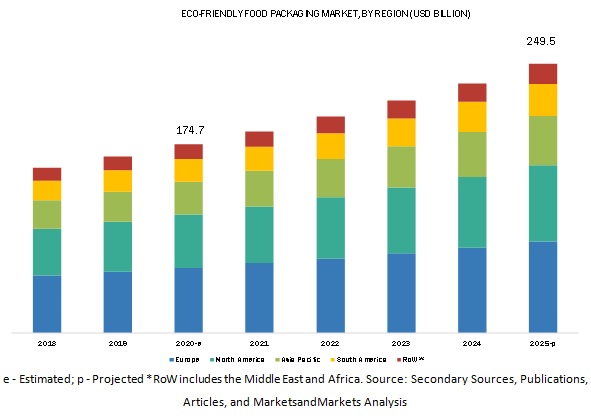According to MarketsandMarkets, the global eco-friendly food packaging market is estimated to be valued at USD 174.7 billion in 2020 and is projected to reach USD 249.5 billion by 2025, recording a CAGR of 7.4%, in terms of value. Stringent government regulations, downsizing in the packaging industry, and technological advancements in the packaging industry for the manufacturing of packaging using non-petroleum products are driving the market for eco-friendly food packaging. Furthermore, innovative products such as edible packaging and water-soluble packaging are also fueling the market for the eco-friendly food packaging market.

By material, the paper & paperboard segment is projected to account for the largest share in the eco-friendly food packaging market during the forecast period
The emulsifiers segment, by ingredient, is expected to dominate the market during the forecast period. This is due to its higher use in the foodservice and retail industry along with the transport of bulk food & beverage products. Paper & paperboards are the most preferred packaging in the food & beverage industry due to their degradable nature and recyclable property. Ready-to-eat, on-the-go, and frozen & fresh foods are nowadays served and transported in the paperboard packaging, which is due to the rise in environmental hazards. Rigid boxes are preferred for transportation. However, fresh products are served inflexible and molded paper & paperboards.
Download PDF Brochure: https://www.marketsandmarkets.com/pdfdownloadNew.asp?id=249469969
By application, the food segment accounted for the largest market size in the global market during the forecast period
The food segment accounted for the largest share in 2019, acquiring approximately 70% of the overall market. Consumers seek convenience food solutions due to lack of time. The expectations of food quality, hygiene, and growing health awareness are driving the eco-friendly packaging market in the food sector. Beverages are usually served in reusable or recyclable products; also, food products can be served in biodegradable packaging, which includes paper & paperboards; this is fueling the growth of the food segment.
The Asia Pacific region is projected to witness the fastest growth during the forecast period
The eco-friendly food packaging market in Asia Pacific is projected to witness the highest growth due to the increasing demand for convenience foods due to the busy lifestyles of consumers. There is increasing consumption of on-the-go and ready-to-eat breakfast meals, as a result of urbanization, hectic lifestyles, and high disposable income. The eco-friendly food packaging industry has been growing as a result of the stringent laws and regulations levied by governments and governing bodies, as well as a shift in consumer preferences toward recyclable and eco-friendly packaging materials. Apart from these factors, the downsizing of packaging and breakthrough in new technologies are also driving the eco-friendly food packaging market globally. However, the high cost of recycling and poor infrastructure available for recycling processes are likely to hamper the growth of this market in underdeveloped regions.
Make an Inquiry: https://www.marketsandmarkets.com/Enquiry_Before_BuyingNew.asp?id=249469969
This report includes a study on the marketing and development strategies, along with the product portfolios of the leading companies. The global eco-friendly food packaging market includes key players such as Amcor (Australia), Mondi Group (Austria), Sealed Air Corporation (US), Ball Corporation (US), Tetra Pak (Sweden), Crown Holding Inc. (US), BASF (Germany), Huhtamaki Oyj (Finland), Westrock (US), Smurfit Kappa (Ireland), Sonoco Company (US), Evergreen (US), Elopak (Norway), Winppak (Canada), Berry Global, (US), Printpack (US), Paperfoam (The Netherlands), and GWP Group (England). These companies are focusing on new product launches and expansions & investments to expand themselves geographically. They have adopted these strategies to utilize their expertise efficiently, enhance their productivity, and introduce their products to newer markets